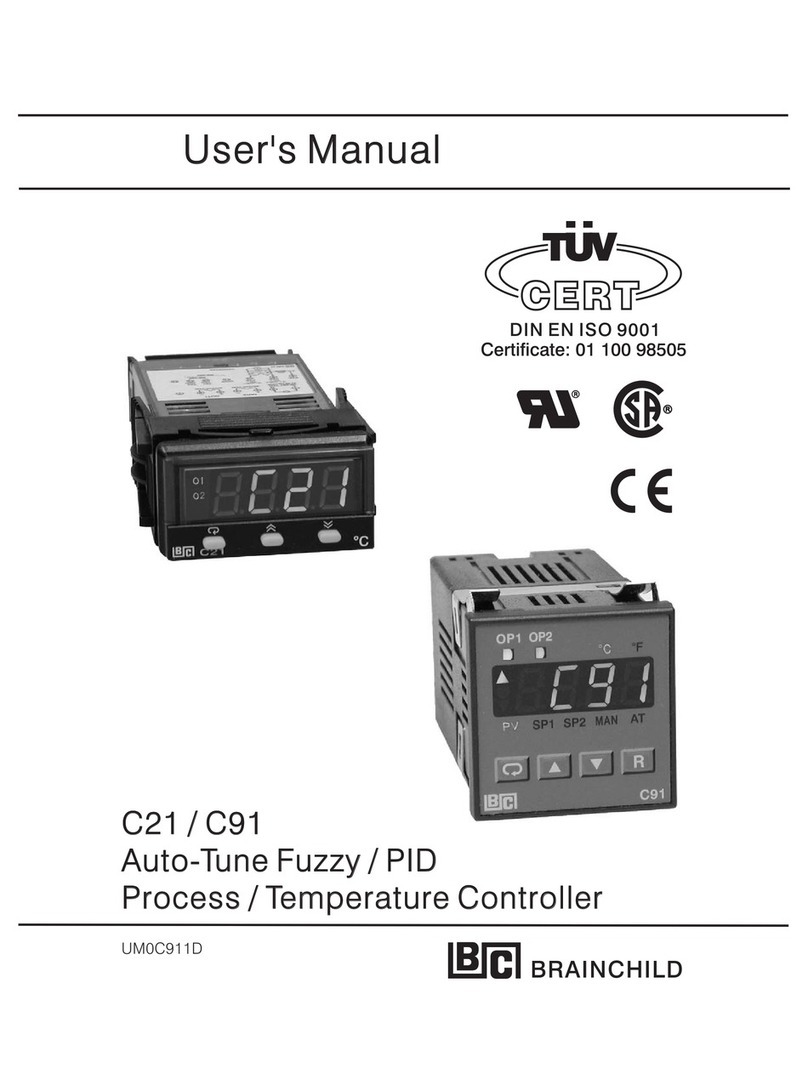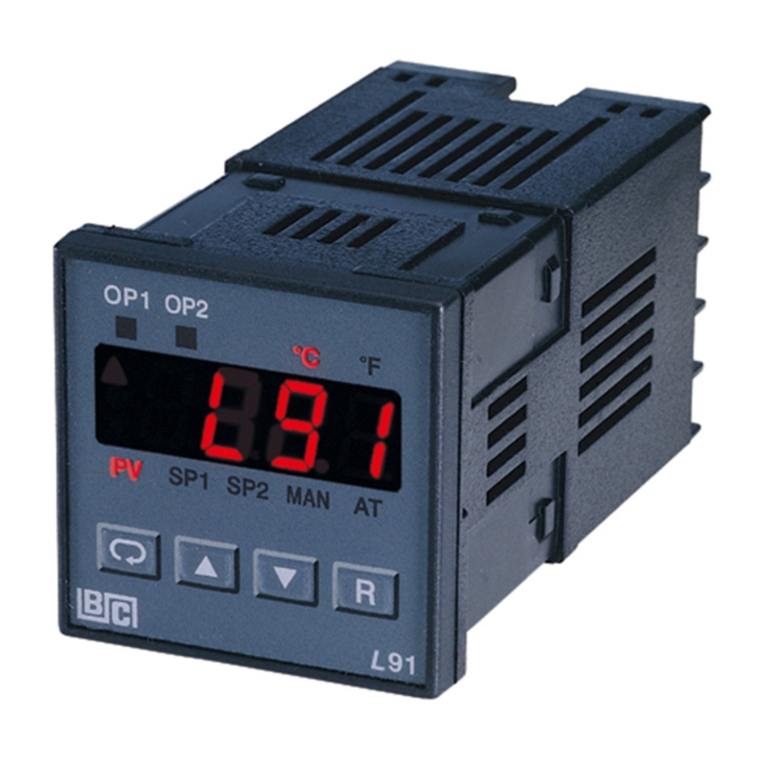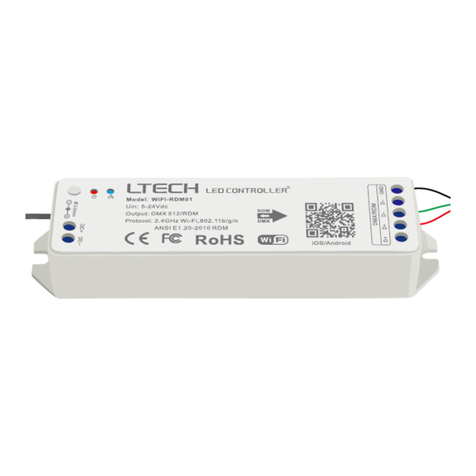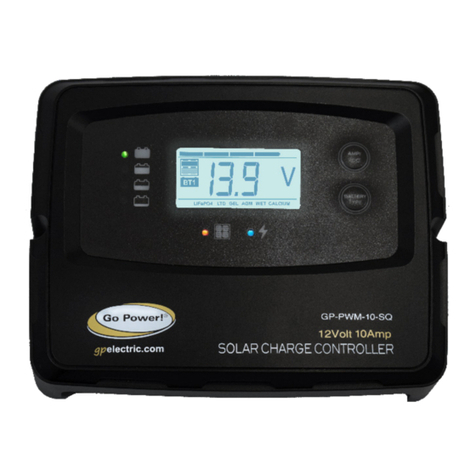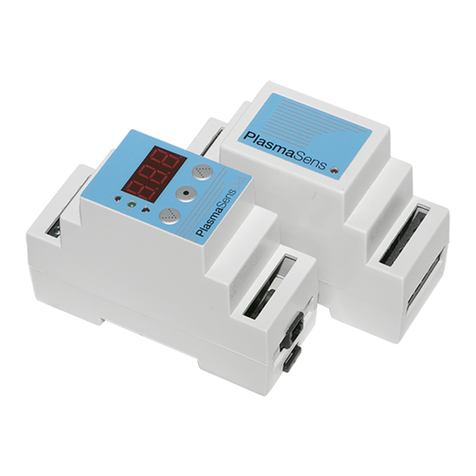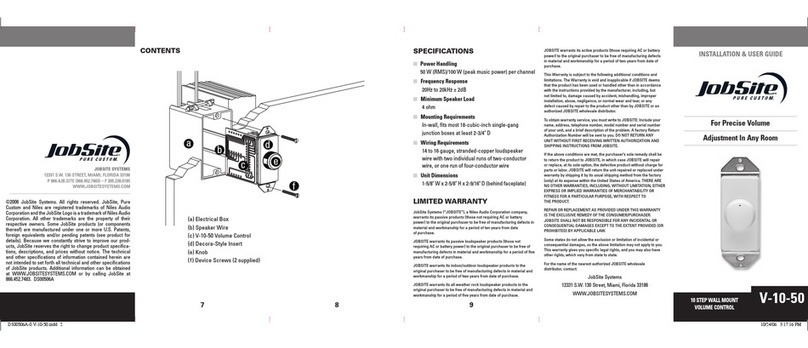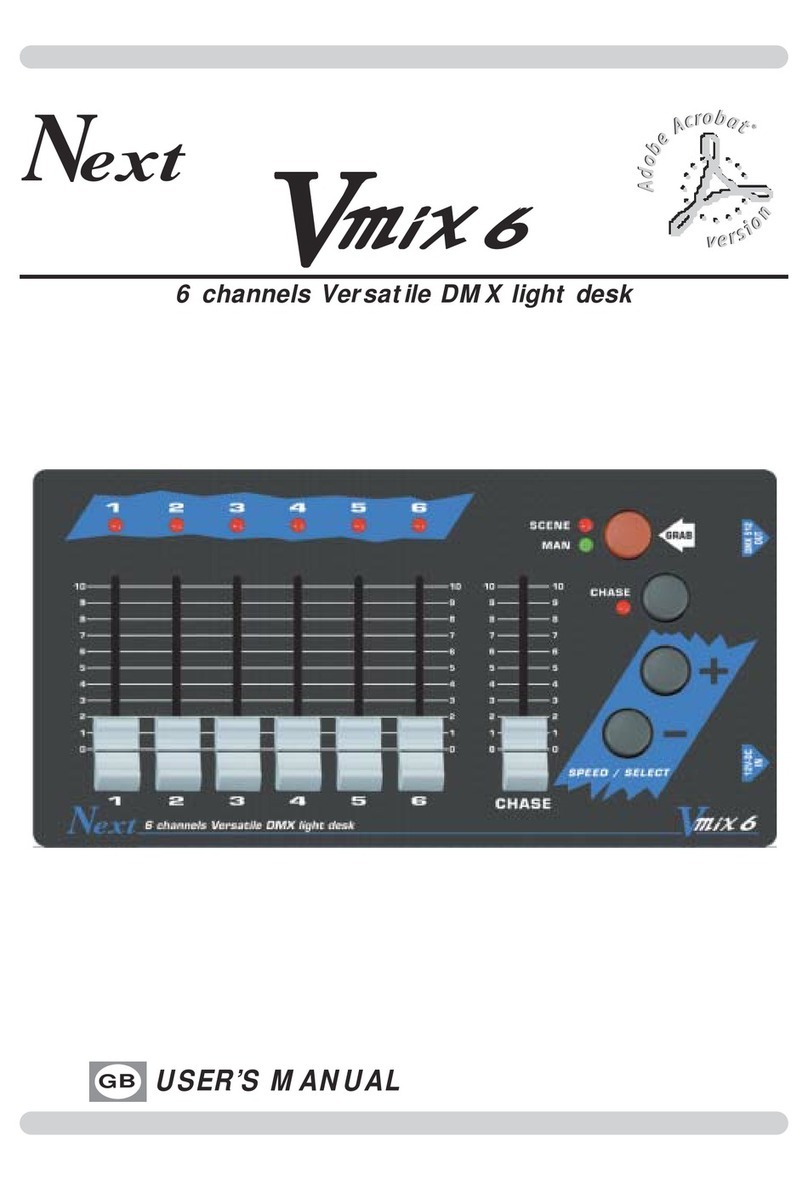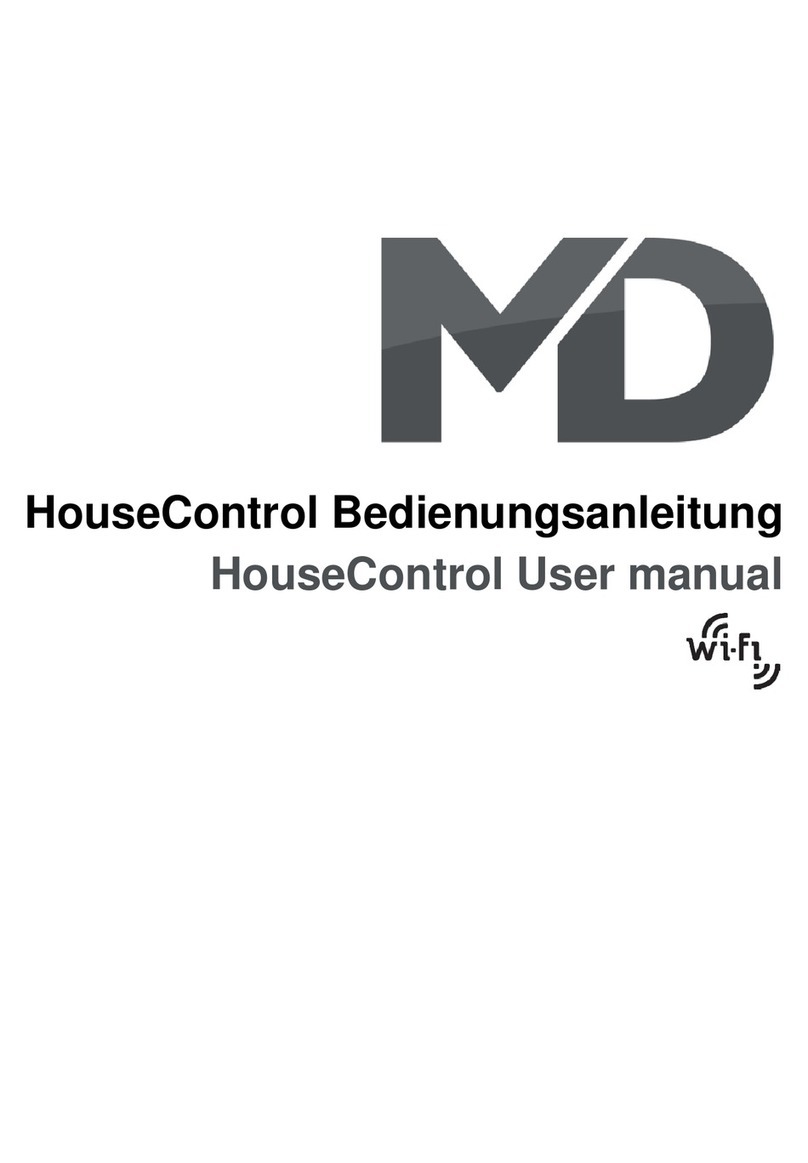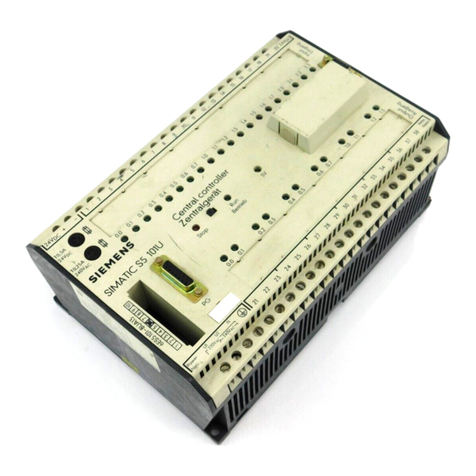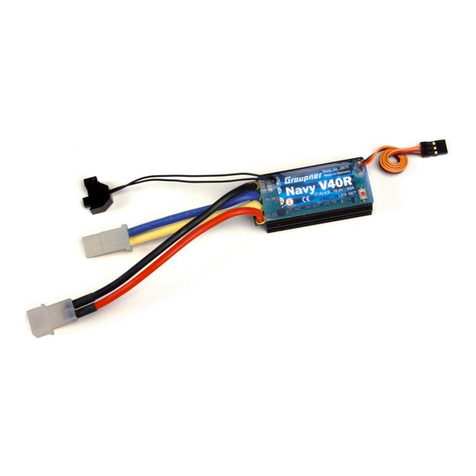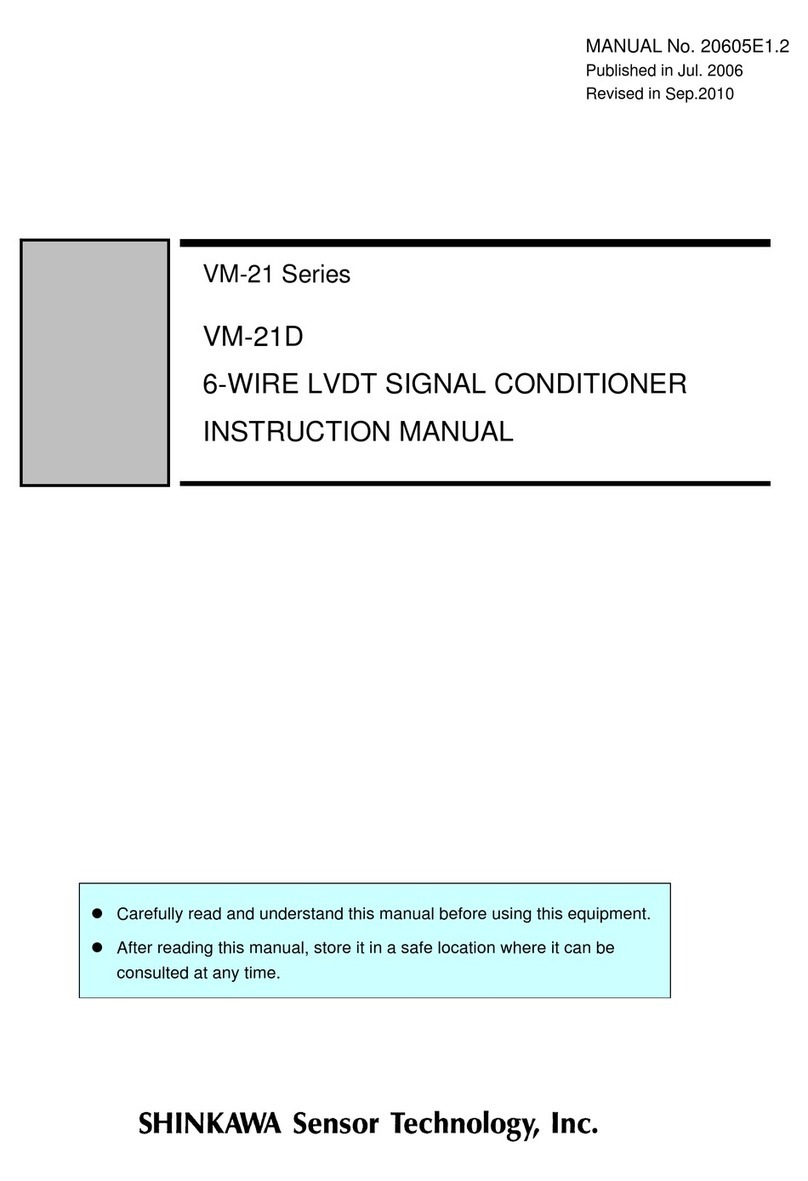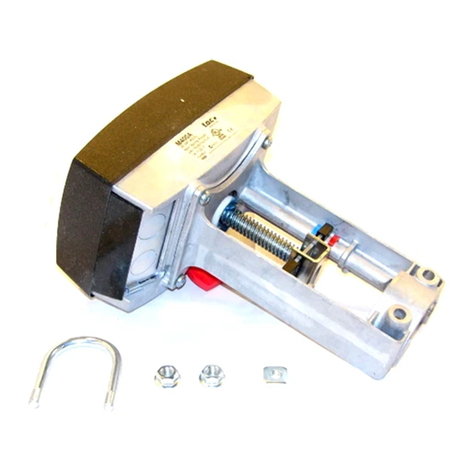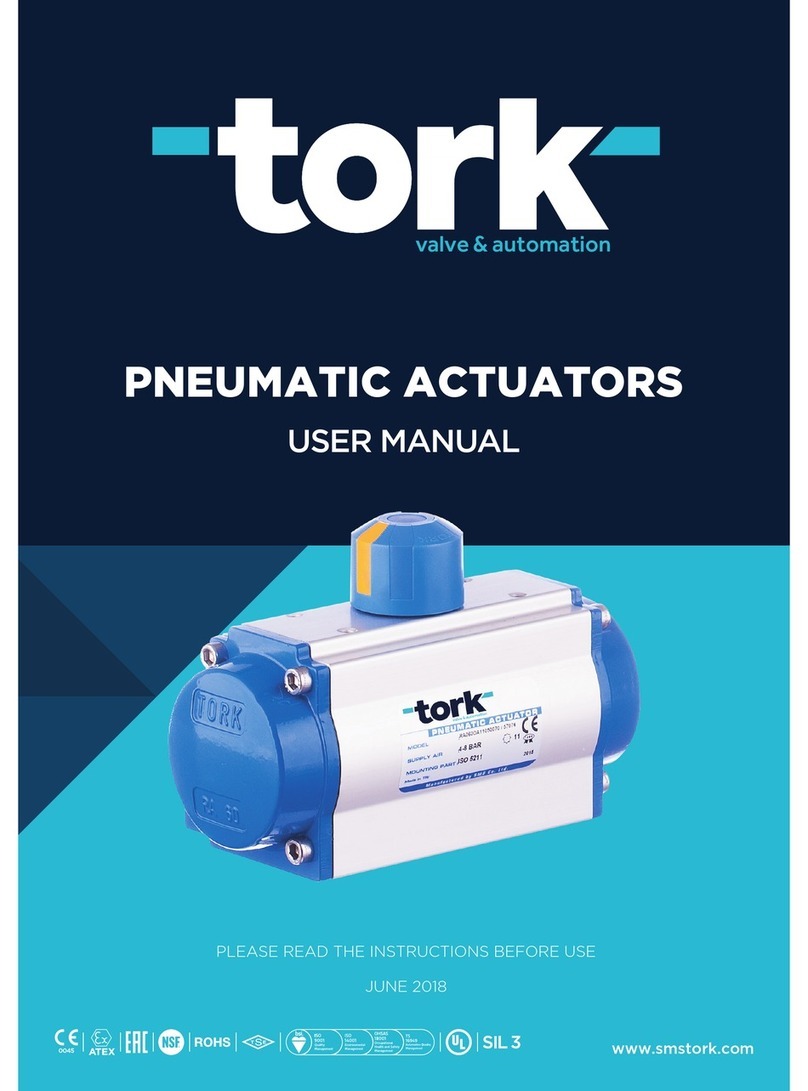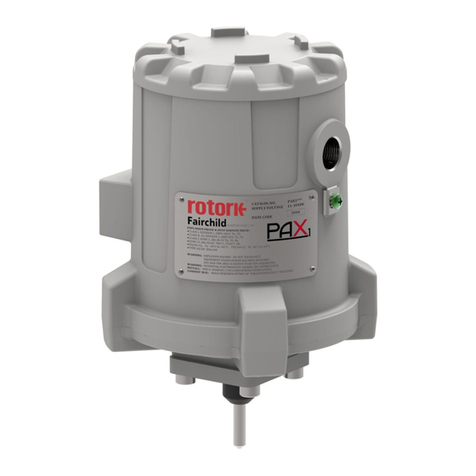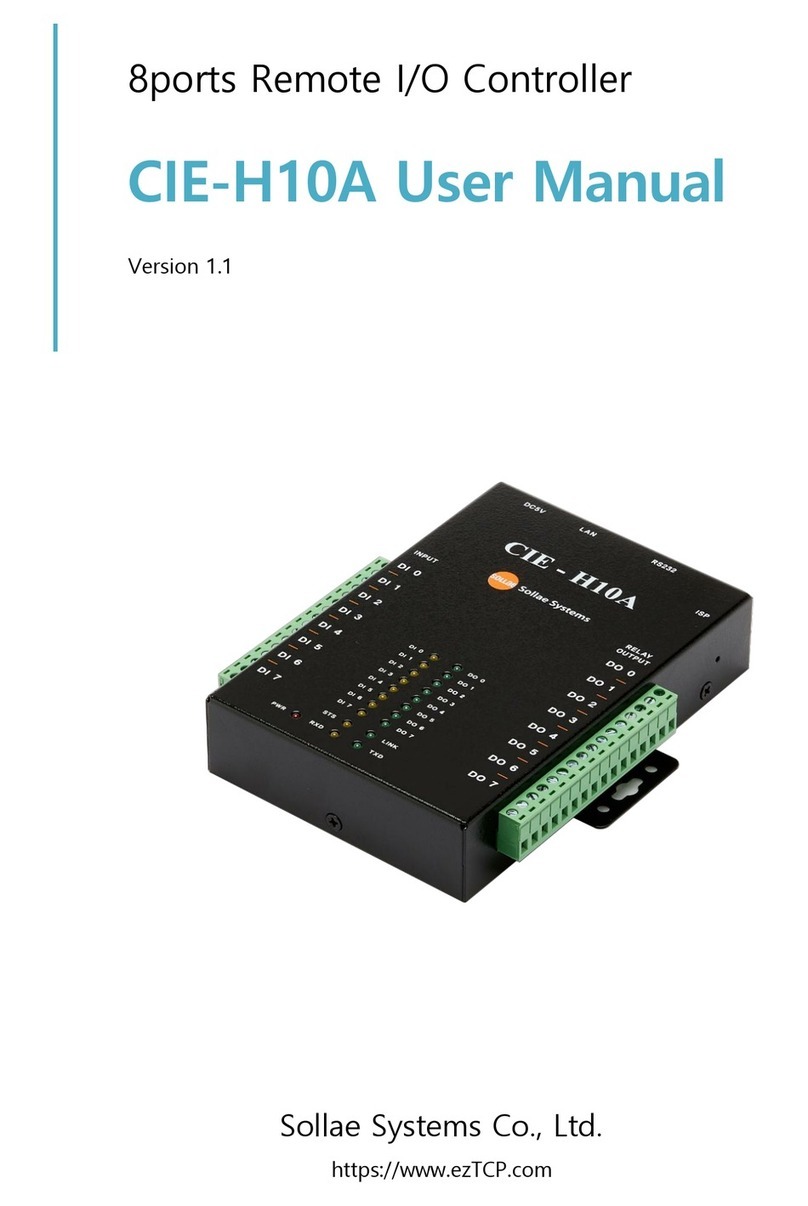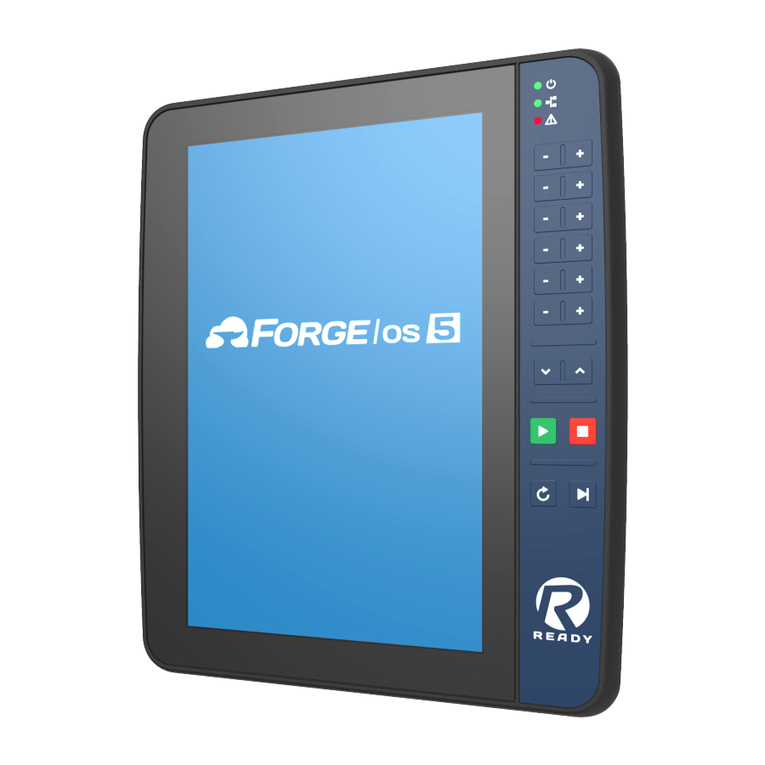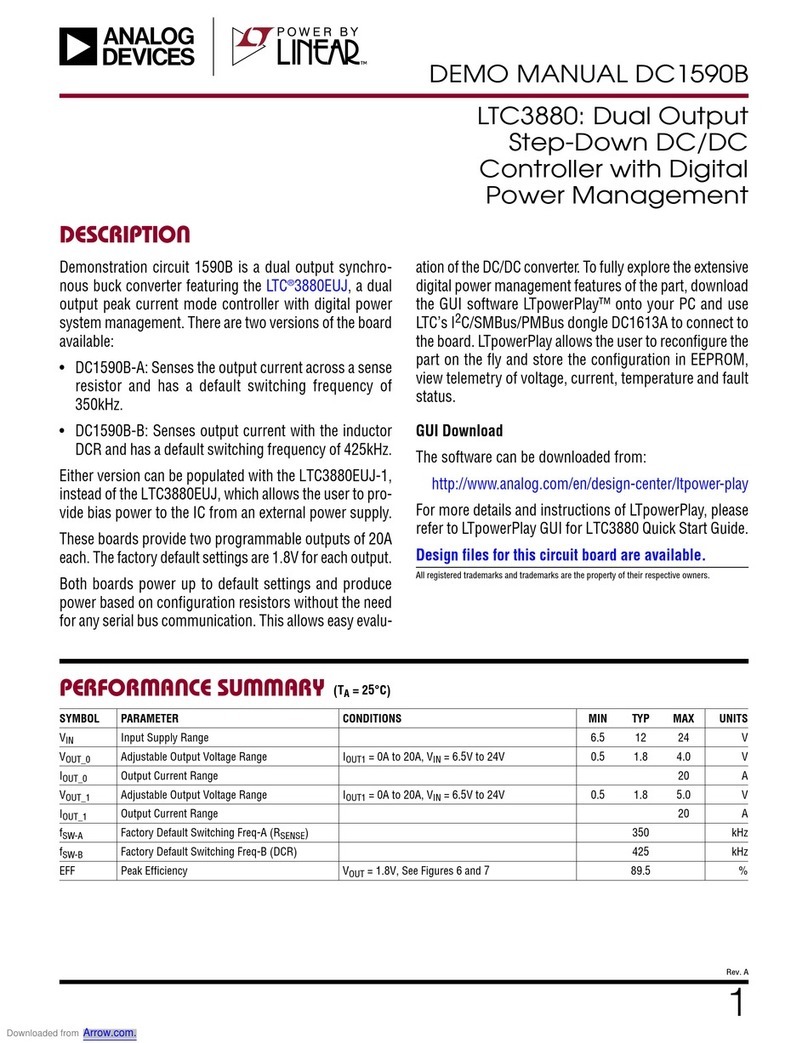Brainchild P41 User manual

User's ManualUser's Manual
P41 / P91
Auto-Tune Fuzzy / PID
Profiling Controller
P41 /P91
Auto-Tune Fuzzy /PID
Profiling Controller
UM0P411D
DIN EN ISO 9001
Certificate: 01 100 98505
R
L
R
LISTED
U

2UM0P411A
Warning SymbolWarning Symbol
Use the ManualUse the Manual
The Symbol calls attention to an operating procedure, practice, or the
like, which, if not correctly performed or adhered to, could result in
personal injury or damage to or destruction of part or all of the
product and system. Do not proceed beyond a warning symbol until
the indicated conditions are fully understood and met.
The Symbol calls attention to an operating procedure, practice, or the
like, which, if not correctly performed or adhered to, could result in
personal injury or damage to or destruction of part or all of the
product and system. Do not proceed beyond a warning symbol until
the indicated conditions are fully understood and met.
Installers
System Designer
Expert User
Installers
System Designer
Expert User
Read Chapter 1, 2
Read All Chapters
Read Page 15,16
Read Chapter 1, 2
Read All Chapters
Read Page 15,16
NOTE:
It is strongly recommended that a process should incorporate a
LIMIT CONTROL like L91 which will shut down the equipment at
a preset process condition in order to preclude possible
damage to products or system.
It is strongly recommended that aprocess should incorporate a
LIMIT CONTROL like L91 which will shut down the equipment at
apreset process condition in order to preclude possible
damage to products or system.
Information in this user's manual is subject to change without notice.Information in this user's manual is subject to change without notice.
Copyright February 2007, The Brainchild Corporation, all rights
reserved. No part of this publication may be reproduced, transmitted,
transcribed or stored in a retrieval system, or translated into any
language in any form by any means without the written permission of
the Brainchild Corporation.
aCopyright February 2007, The Brainchild Corporation, all rights
reserved. No part of this publication may be reproduced, transmitted,
transcribed or stored in a retrieval system, or translated into any
language in any form by any means without the written permission of
the Brainchild Corporation.
a
This manual is applicable for the products with software version
12 and later version.
This manual is applicable for the products with software version
12 and later version.

3
UM0P411B
Contents
Chapter 1 OverviewChapter 1Overview
Page No
Chapter 2 Installation
Chapter 2Installation
Chapter 3 ConfigurationChapter 3Configuration
3-1 Password---------------------- 44
3-2 Signal Input ------------------ 44
3-3 Event Input ------------------- 45
3-4 Control Outputs ------------- 46
3-5 Alarms ------------------------- 51
3-6 Configure Home Page ----- 55
3-7 User Calibration ------------- 55
3-8 Digital Filter ------------------- 57
3-9 Failure Transfer -------------- 58
3-10 Auto-tuning ----------------- 59
3-11 Manual tuning ------------- 60
3-12 Manual Mode -------------- 62
3-13 Data Communication ---- 62
3-14 Retransmission ------------ 63
3-15 Output Scaling ------------- 64
Chapter 4 Profiler Operation
Chapter 4Profiler Operation
Chapter 5 Applications -------78Chapter 5Applications
Chapter 6 Specifications ---- 80Chapter 6Specifications
Page No
Appendix A-1 ------------------ 97
Appendix A-2 ------------------ 98
Appendix A-1
Appendix A-2
Chapter 7
Modbus Communications --- 86
Chapter 7
Modbus Communications
7-1 Functions Supported -------86
7-2 Exception Responses ------88
7-3 Parameter Table -------------88
7-4 Number System -------------89
7-5 Communication Example --89
1-1 General ------------------------- 5
1-2 Ordering Code ---------------- 9
1-3 Programming Port ---- ----- 11
1-4 Keys and Displays ----------12
1-5 Key Operation Flowchart---15
1-6 Parameter Descriptions ----17
-
2-1 Unpacking -------------------- 32
2-2 Mounting --------------------- 32
2-3 Wiring precautions --------- 34
2-4 Power Wiring ---------------- 36
2-5 Sensor Input Wiring -------- 36
2-6 Control Output Wiring ----- 36
2-7 Alarm /Event Output Wiring ---
----------------------------------- 40
2-8 Event Input Wiring ---------- 41
2-9 Retransmission Output ----tt
Wiring ------------------------- 41
2-10 Data Communication ---- 42
4-1 What is set point profiler ---
4-2 Segment connection -------
4-3 Profiler Modes ---------------
4-4 Running, holding and ----------
aborting a profile -----------
4-5 Viewing and modifying --------
profile progress ------------
4-6 Start ----------------------------
4-7 Holdback ---------------------
4-8 Power failure -----------------
4-9 Configuring the profiler ----
4-10 Viewing and creating a -------
profile ------------------------
4-11 Event Outputs and PID -------
Selection --------------------
65
66
66
67
68
68
68
71
73
73
77
Chapter 8
Manual Calibration ----------- 95
Chapter 8
Manual Calibration

4UM0P411A
Figure 1.1 Fuzzy Control Advantage ------------------------------------------------------------------------------- 6
Figure 1.2 Programming Port Overview -------------------------------------------------------------------------- 11
Figure 1.3 Front Panel Description ------------------------------------------------------------------------------- 13
Figure 1.4 Program code display --------------------------------------------------------------------------------- 14
Figure 2.1 ounting Dimensions --------------------------------------------------------------------------------- 33
Figure 2.2 Lead Termination for P41------------------------------------------------------------------------------ 34
Figure 2.3 Lead Termination for P91------------------------------------------------------------------------------ 34
Figure 2.4 Rear Terminal Connection for P41 -------------------------------------------------------------------35
Figure 2.5 Rear Terminal Connection for P91 ------------------------------------------------------------------ 35
Figure 2.6 Power Supply Connections -------------------------------------------------------------------------- 36
Figure 2.7 Sensor Input Wiring ------------------------------------------------------------------------------------ 36
Figure 2.8 Output 1 Relay or Triac (SSR) to Drive Load ------------------------------------------------------ 36
Figure 2.9 Output 1 Relay or Triac (SSR) to Drive Contactor ------------------------------------------------ 37
Figure 2.10 Output 1 Pulsed Voltage to Drive SSR ------------------------------------------------------------ 37
Figure 2.11 Output 1 Linear Current ----------------------------------------------------------------------------- 38
Figure 2.12 Output 1 Linear Voltage ----------------------------------------------------------------------------- 38
Figure 2.13 Output 2 Relay or Triac (SSR) to Drive Load -----------------------------------------------------38
Figure 2.14 Output 2 Relay or Triac (SSR) to Drive Contactor ---------------------------------------------- 39
Figure 2.15 Output 2 Pulsed Voltage to Drive SSR ----------------------------------------------------------- 39
Figure 2.16 Output 2 Linear Current ----------------------------------------------------------------------------- 39
Figure 2.17 Output 2 Linear Voltage ----------------------------------------------------------------------------- 40
Figure 2.18 Alarm / Event output wiring ------------------------------------------------------------------------- 40
Figure 2.19 Alarm Output to Drive Contactor ------------------------------------------------------------------ 40
Figure 2.20 Event Input wiring ------------------------------------------------------------------------------------ 41
Figure 2.21 Retransmit 4-20 / 0-20 mA Wiring ----------------------------------------------------------------- 41
Figure 2.22 RS-485 Wiring ---------------------------------------------------------------------------------------- 42
Figure 2.23 RS-232 Wiring -----------------------------------------------------------------------------------------43
Figure 2.24 Configuration of RS-232 Cable -------------------------------------------------------------------- 43
Figure 3.1 Conversion Curve for Linear Type Process Value ------------------------------------------------ 45
Figure 3.2 Heat Only ON-OFF Control -------------------------------------------------------------------------- 47
Figure 3.3 Heat - cool Control ------------------------------------------------------------------------------------- 49
Figure 3.4 Process high alarm 1 operation --------------------------------------------------------------------- 51
Figure 3.5 Process low alarm 1 operation ---------------------------------------------------------------------- 51
Figure 3.6 Deviation high alarm 1 operation ------------------------------------------------------------------- 52
Figure 3.7 Deviation low alarm 1 operation -------------------------------------------------------------------- 52
Figure 3.8 Deviation band alarm 1 operation ------------------------------------------------------------------ 53
Figure 3.9 Two point user calibration ---------------------------------------------------------------------------- 56
Figure 3.10 Filter Characteristics -------------------------------------------------------------------------------- 57
Figure 3.11 Effects of PID Adjustment --------------------------------------------------------------------------- 61
Figure 3.12 Output scaling function ----------------------------------------------------------------------------- 64
Figure 4.1 Set point profile ---------------------------------------------------------------------------------------- 65
Figure 4.2 Holdback operation ----------------------------------------------------------------------------------- 70
Figure 4.3 Recovery from profile at dwell segment ----------------------------------------------------------- 71
Figure 4.4 Recovery from profile at ramp segment ------------------------------------------------------------71
Figure 4.5 Recovery from PV at dwell segment --------------------------------------------------------------- 72
Figure 4.6 Recovery from PV at ramp segment --------------------------------------------------------------- 72
Figure 4.7 Profiling curve example ------------------------------------------------------------------------------- 75
Figure 5.1 A Heat Treatment Oven ------------------------------------------------------------------------------- 78
Figure 5.2 Temperature profile of the Heat Treatment Oven -------------------------------------------------79
Table 3.1 Password operation ------------------------------------------------------------------------------------ 44
Table 3.2 Heat-Cool control configuration value -------------------------------------------------------------- 46
Table 3.3 Alarm mode description ------------------------------------------------------------------------------- 54
Table 3.4 PID Adjustment Guide ---------------------------------------------------------------------------------- 60
Table 4.1 Segment types ------------------------------------------------------------------------------------------- 65
Table 4.2 Profiler odes -------------------------------------------------------------------------------------------- 67
Table 4.3 Parameters that follow segment type ---------------------------------------------------------------- 74
Table 7.1 Exception Code Table ---------------------------------------------------------------------------------- 88
Table 7.2 Number Conversion Table ----------------------------------------------------------------------------- 89
Table A.1 Error Codes and Corrective Actions ---------------------------------------------------------------- 95
Figures & TablesFigures &Tables Page No

Chapter 1 OverviewChapter 1Overview
1-1 General1-1 General
The Fuzzy Logic plus PID microprocessor-based profiling controller
series, incorporate two bright, easy to read 4-digit LED displays,
indicating process value and set point value. The Fuzzy Logic
technology enables a process to reach a predetermined set point in
the shortest time, with the minimum of overshoot during power-up or
external load disturbance.
P91 is a 1/16 DIN size panel mount profiling controller. It can also be
used for rail mount by adding a rail mount kit. P41 is a 1/4 DIN size
panel mount controller. These units are powered by 11-26 or
90-250 VDC/VAC supply, incorporatinga2amp.controlrelayoutput
as standard. The second output can be used as cooling control, an
event output or an alarm. Both outputs can select triac, logic output,
linear current or linear voltage to drive external device. The units are
fully programmable for PT100 and thermocouple types J, K, T, E, B, R,
S, N, L, C, P with no need to modify the unit. The input signal is
digitized by using a 18-bit A to D converter. Its fast sampling rate
allows the unit to control fast processes.
There are more functions than the heating and cooling control could be
configured for the controller outputs, these include: up to three alarm
outputs, up to three event outputs and up to two analog retransmission
outputs.
Digital communications RS-485 or RS-232 are available as an
additional option. These options allow the units to be integrated with
supervisory control system and software.
A programming port is available for automatic configuration,
calibration and testing without the need to access the keys on front
panel.
By using proprietary Fuzzy modified PID technology, the control
loop will minimize the overshoot and undershoot in a shortest
time. The following diagram is a comparison of results with and
without Fuzzy technology.
profiling
UM0P411A 5

PID control with properly tuned
PID + Fuzzy control
Warm Up Load Disturbance
Set
point
Temperature
Time
Figure 1.1
Fuzzy Control
Advantage
Figure 1.1
Fuzzy Control
Advantage
The series can be configured as a single set point controller (static
mode) or a ramp and dwell profiling controller (profile mode). The
profile mode feature allows the user to program up to 9 profiles of
up to 64 free-format (ramp, dwell, jump or end) segments each. The
total segments available for the product is 288 segments.
The profiling controllers contain the following features:
Flexible Configuration of ProgramFlexible Configuration of Program
Thereareupto64segmentscanbedefinedforaprofile.Each
segment can be configured as a ramp or a dwell (soak) segment or
defining a repeat number of cycles at arbitray location within the profile
and finally terminated by an end segment.The user can edit a currently
running profile.
Maximum Capacity of Program
Maximum Capacity of Program
There are at most 9 profiles can be defined and 288 segments totally
available for all profiles. The profiles are divide into three kinds of length.
The short length profile contains 16 segments, the medium length profile
contains 32 segments while the long length profile contains 64 segments
at most.
Event Input
Event Input
The event input feature allows the user to select one of eight functions:
enter profile run mode, enter profile hold mode, abort profile mode,
enter manual mode, perform failure transfer, enter off mode, advance
to the next segment and select second set of PID values.
UM0P411A
6

Programmable Event OutputsProgrammable Event Outputs
Up to three relays are configurable for event outputs and the state of
each output can be defined for each segment and end of profile.
Analog Retransmission
Analog Retransmission
The output 5 and output 4 (P41 only) of the products can be equipped
with analog output module. The output can be configured for transmitting
the process value as well as set point value.
High Accuracy
High Accuracy
The series are manufactured with custom designed ASIC(Application
Specific Integrated Circuit ) technology which contains a 18-bit A to
D converter for high resolution measurement ( true 0.1 F resolution
for thermocouple and PT100 ) and a 15-bit D to A converter for linear
current or voltage control output. The ASIC technology provides
improved operating performance, low cost, enhanced reliability and
higher density.
B
Fast Sampling Rate
Fast Sampling Rate
The sampling rate of the input A to D converter reaches 5 times/second.
The fast sampling rate allows this series to control fast processes.
Fuzzy ControlFuzzy Control
The function of Fuzzy control is to adjust PID parameters from time to
time in order to make manipulation output value more flexible and
adaptive to various processes. The results is to enable a process to
reach a predetermined set point in the shortest time, with the minimum
of overshoot and undershoot during power-up or external load
disturbance.
Digital Communication
Digital Communication
The units are equipped with RS-485 or RS-232 interface card to
provide digital communication. By using the twisted pair wires there
are at most 247 units can be connected together via RS-485 interface
to a host computer.
UM0P411A 7

Programming PortProgramming Port
A programming port is used to connect the unit to a hand-held
programmer or a PC for quick configuration, also can be connected
to an ATE system for automatic testing & calibration.
Auto-tune
The auto-tune function allows the user to simplify initial setup for a
new system. A clever algorithm is provided to obtain an optimal set
of control parameters for the process, and it can be applied either as
the process is warming up ( cold start ) or as the process has been
in steady state ( warm start ).
Lockout Protection
Lockout Protection
According to actual security requirement, a password is provided to
prevent the unit from being changed abnormally.
Bumpless Transfer
Bumpless Transfer
Bumpless transfer allows the controller to continue to control by
using its previous value as the sensor breaks. Hence, the process
can be well controlled temporarily as if the sensor is normal.
Digital Filter
Digital Filter
A first order low pass filter with a programmable time constant is used
to improve the stability of process value. This is particularly useful in
certain application where the process value is too unstable to be read.
SEL Function
SEL Function
The units have the flexibility for user to select those parameters which
are most significant to him and put these parameters in the home page.
There are at most 8 parameters can be selected to allow the user to
build his own display sequence.
UM0P411A
8

Power InputPower Input
4: 90 - 250 VAC, 47-63 Hz
5: 11 - 26 VAC or VDC,
SELV, Limited Energy
4: 90 -250 VAC, 47-63 Hz
5: 11 -26 VAC or VDC,
SELV, Limited Energy
0: None
1: Relay rated 2A/240VAC
2: Pulsed voltage to drive SSR, 5V/30mA
3: Retransmit 4 - 20mA / 0 - 20mA
4: Retransmit 1 - 5V / 0 - 5V/0 - 10V
6: Triac output 1A / 240VAC,SSR
7: Isolated 20V/25mA
transducer power supply
8: Isolated 12V/40mA
transducer power supply
A: Isolated 5V/80mA
transducer power supply
C: Pulsed voltage to drive SSR, 14V/40mA
9: Special order
0: None
1: Relay rated 2A/240VAC
2: Pulsed voltage to drive SSR, 5V/30mA
3: Retransmit 4 - 20mA /0-20mA
4: Retransmit 1 - 5V /0-5V/0 -10V
6: Triac output 1A /240VAC,SSR
7: Isolated 20V/25mA
transducer power supply
8: Isolated 12V/40mA
transducer power supply
A: Isolated 5V/80mA
transducer power supply
C: Pulsed voltage to drive SSR, 14V/40mA
9: Special order
Output 4Output 4
1: Standard Input
Thermocouple:
J, K, T, E, B, R, S, N, L,
C, P
RTD: PT100 DIN, PT100 JIS
Voltage: 0-60mV
5: 0-10V, 0-1V, 0-5V, 1-5V
6: 0-20/4-20 mA
9: Special Order
1: Standard Input
Thermocouple:
J, K, T, E, B, R, S, N, L,
C, P
RTD: PT100 DIN, PT100 JIS
Voltage: 0-60mV
5: 0-10V, 0-1V, 0-5V, 1-5V
6: 0-20/4-20 mA
9: Special Order
Signal InputSignal Input
0: None
1: Relay rated 2A/240VAC
2: Pulsed voltage to drive SSR, 5V/30mA
3: Isolated 4 - 20mA / 0 - 20mA
4: Isolated 1 - 5V / 0 - 5V/0 - 10V
6: Triac output 1A / 240VAC,SSR
7: Isolated 20V/25mA transducer power supply
8: Isolated 12V/40mA transducer power supply
A: Isolated 5V/80mA transducer power supply
C: Pulsed voltage to drive SSR, 14V/40mA
9: Special order
0: None
1: Relay rated 2A/240VAC
2: Pulsed voltage to drive SSR, 5V/30mA
3: Isolated 4 - 20mA / 0 - 20mA
4: Isolated 1 - 5V / 0 - 5V/0 -10V
6: Triac output 1A /240VAC,SSR
7: Isolated 20V/25mA transducer power supply
8: Isolated 12V/40mA transducer power supply
A: Isolated 5V/80mA transducer power supply
C: Pulsed voltage to drive SSR, 14V/40mA
9: Special order
P91-
1-2 Ordering Code1-2 Ordering Code
0: Panel mount IP50 standard
1: Panel mount IP65 water resistant
rubber installed
2: DIN rail mount with IP50
(for P91 only)
3: DIN rail mount with IP65
(for P91 only)
0: Panel mount IP50 standard
1: Panel mount IP65 water resistant
rubber installed
2: DIN rail mount with IP50
(for P91 only)
3: DIN rail mount with IP65
(for P91 only)
Options
0: None
1: Relay rated 2A/240VAC
2: Pulsed voltage to drive SSR, 5V/30mA
6: Triac output 1A / 240VAC,SSR
7: Isolated 20V/25mA transducer power supply
8: Isolated 12V/40mA transducer power supply
A: Isolated 5V/80mA transducer power supply
C: Pulsed voltage to drive SSR, 14V/40mA
9: Special order
0: None
1: Relay rated 2A/240VAC
2: Pulsed voltage to drive SSR, 5V/30mA
6: Triac output 1A /240VAC,SSR
7: Isolated 20V/25mA transducer power supply
8: Isolated 12V/40mA transducer power supply
A: Isolated 5V/80mA transducer power supply
C: Pulsed voltage to drive SSR, 14V/40mA
9: Special order
Output 3Output 3
0: None
1: Relay rated 2A/240VAC
2: Pulsed voltage to drive SSR,
5V/30mA
3: Isolated 4 - 20mA / 0 - 20mA
4: Isolated 1 - 5V / 0 - 5V/0 - 10V
6: Triac output 1A / 240VAC,SSR
C: Pulsed voltage to drive SSR,
14V/40mA
9: Special order
0: None
1: Relay rated 2A/240VAC
2: Pulsed voltage to drive SSR,
5V/30mA
3: Isolated 4 - 20mA /0-20mA
4: Isolated 1 - 5V / 0 - 5V/0 -10V
6: Triac output 1A /240VAC,SSR
C: Pulsed voltage to drive SSR,
14V/40mA
9: Special order
Output 2Output 2
UM0P411C
Output 1Output 1
9
Output 5Output 5
0: None
3: Retransmit 4 - 20mA / 0 - 20mA
4: Retransmit 1 - 5V / 0 - 5V/0 - 10V
7: Isolated 20V/25mA
transducer power supply
8: Isolated 12V/40mA
transducer power supply
A: Isolated 5V/80mA
transducer power supply
D: Isolated RS-485 interface
E: Isolated RS-232 interface
0: None
3: Retransmit 4 - 20mA /0-20mA
4: Retransmit 1 - 5V / 0 - 5V/0 -10V
7: Isolated 20V/25mA
transducer power supply
8: Isolated 12V/40mA
transducer power supply
A: Isolated 5V/80mA
transducer power supply
D: Isolated RS-485 interface
E: Isolated RS-232 interface
P41-
0
Standard leave blank
Special Order AA-ZZ
Standard leave blank
Special Order AA-ZZ

OM94-6 = Isolated 1A / 240VAC Triac Output Module ( SSR )
OM94-7 = 14V / 40mA SSR Drive Module
OM98-3 = Isolated 4 - 20 mA /0-20mA Analog Output Module
OM98-5 = Isolated 0 -10V Analog Output Module
CM94-1 = Isolated RS-485 Interface Module for P41 Output 5
CM94-2 = Isolated RS-232 Interface Module for P41 Output 5
CM94-3 = Isolated 4-20mA/0-20mA Retrans Module for P41 Output 5
CM94-5 = Isolated 0-10V Retrans Module for P41 Output 5
CM97-1 = Isolated RS-485 Interface Module for P91 Output 5
CM97-2 = Isolated RS-232 Interface Module for P91 Output 5
CM97-3 = Isolated 4-20mA/0-20mA Retrans Module for P91 Output 5
CM97-5 = Isolated 0-10V Retrans Module for P91 Output 5
DC94-1 = Isolated 20V/25mA DC Output Power Supply
DC94-2 = Isolated 12V/40mA DC Output Power Supply
DC94-3 = Isolated 5V/80mA DC Output Power Supply
DC97-1 = Isolated 20V/25mA DC Output Power Supply for P91 Output 5
DC97-2 = Isolated 12V/40mA DC Output Power Supply for P91 Output 5
DC97-3 = Isolated 5V/80mA DC Output Power Supply for P91 Output 5
CC94-1 = RS-232 Interface Cable ( 2M )
CC91-1 = Programming Port Cable
RK91-1 = Rail Mount kit for BTC-9100 / P91
DC21-1 = Isolated 20V/25mA DC Output Power Supply for P41 Output 5
DC21-2 = Isolated 12V/40mA DC Output Power Supply for P41 Output 5
DC21-3 = Isolated 5V/80mA DC Output Power Supply for P41 Output 5
OM94-6 = Isolated 1A / 240VAC Triac Output Module ( SSR )
OM94-7 = 14V / 40mA SSR Drive Module
OM98-3 = Isolated 4 - 20 mA / 0 - 20 mA Analog Output Module
OM98-5 = Isolated 0 -10V Analog Output Module
CM94-1 = Isolated RS-485 Interface Module for P41 Output 5
CM94-2 = Isolated RS-232 Interface Module for P41 Output 5
CM94-3 = Isolated 4-20mA/0-20mA Retrans Module for P41 Output 5
CM94-5 = Isolated 0-10V Retrans Module for P41 Output 5
CM97-1 = Isolated RS-485 Interface Module for P91 Output 5
CM97-2 = Isolated RS-232 Interface Module for P91 Output 5
CM97-3 = Isolated 4-20mA/0-20mA Retrans Module for P91 Output 5
CM97-5 = Isolated 0-10V Retrans Module for P91 Output 5
DC94-1 = Isolated 20V/25mA DC Output Power Supply
DC94-2 = Isolated 12V/40mA DC Output Power Supply
DC94-3 = Isolated 5V/80mA DC Output Power Supply
DC97-1 = Isolated 20V/25mA DC Output Power Supply for P91 Output 5
DC97-2 = Isolated 12V/40mA DC Output Power Supply for P91 Output 5
DC97-3 = Isolated 5V/80mA DC Output Power Supply for P91 Output 5
CC94-1 = RS-232 Interface Cable ( 2M )
CC91-1 = Programming Port Cable
RK91-1 = Rail Mount kit for BTC-9100 / P91
DC21-1 = Isolated 20V/25mA DC Output Power Supply for P41 Output 5
DC21-2 = Isolated 12V/40mA DC Output Power Supply for P41 Output 5
DC21-3 = Isolated 5V/80mA DC Output Power Supply for P41 Output 5
Accessories
SNA12A = Smart Network Adapter for programming port to RS-232
interface
BC-Set = Configuration Software
SNA12A = Smart Network Adapter for programming port to RS-232
interface
BC-Set = Configuration Software
Related ProductsRelated Products
UM0P411A
10
SNA10A = Smart Network Adaptor for Brainchild Software Communicator
- or third party software, which converts 255 channels of
- RS-485 or RS-422 to RS-232 Network.
SNA10A = Smart Network Adaptor for Brainchild Software Communicator
-or third party software, which converts 255 channels of
-RS-485 or RS-422 to RS-232 Network.

1-3 Programming Port1-3 Programming Port
A special connector can be used to touch the programming port
which is connected to a PC for automatic configuration, also can be
connected to an ATE system for automatic calibration and testing.
The programming port is used for off-line automatic setup and testing
procedures only. Don't attempt to make any connection to these pins
when the unit is used for a normal control purpose.
UM0P411A 11
Front
Panel
Rear
Terminal
Access HoleAccess Hole
1
3
!
4
"
6
$
Figure 1.2
Programming Port
Overview
Figure 1.2
Programming Port
Overview
2
5
#

1- 4 Keys and Displays1- 4 Keys and Displays
KEYPAD OPERATIONKEYPAD OPERATION
SCROLL KEY :
UP KEY :
DOWN KEY :
PAGE KEY:
This key is used to select a parameter to be viewed or adjusted.
This key is used to increase the value of selected parameter.
This key is used to decrease the value of selected parameter.
This key is used to select desired page of parameters.
SCROLL KEY :
UP KEY :
DOWN KEY :
PAGE KEY:
Press both and keys to :
1. Revert the display to display the process value.
2. Reset the latching alarm, once the alarm condition is
removed.
3. Stop the manual control mode , auto-tuning mode and off
mode, then enters the static mode.
4. Clear the message of communication error, holdback time
out error and auto-tuning error.
5. To reset new profile start segment to 1.00 after earlier profile is
completed when " RUN" and "HLD" LED's are blinking together.
ENTER KEY : Press for 5 seconds to :
1. Enter the selected mode to run.
2. Execute calibration procedure for the low point and high point
calibration.
ENTER KEY :
UM0P411B
12
REVERSE SCROLL :REVERSE SCROLL :
Press both and keys to jump to the previous parameter.
RESET KEY :RESET KEY :

P41
Out3
Out4
Out2
Out1
RUN
HLD
58
28
LCLC
LFLF
Output Status
indicators for
output1~output 4
Upper Display, to display process value,
menu symbol and error code etc.
Lower Display, to display set point value,
parameter value or control output value etc.
4 Buttons for ease of control setup and
set point adjustment.
On : profile held
Flashing: profile in holdback
state
On : profile running
Flashing: profile in delayed state
: Running ramp up segment
:Running ramp down segment
: Running dwell segment
: profile held or in static
mode
Both off
Figure 1.3 Front Panel DescriptionFigure 1.3 Front Panel Description
UM0P411B 13
OP1 OP2 OP3
RUN
P91
CF
HLD
4 Buttons for ease of control setup and
set point adjustment.
: Running ramp up segment
:Running ramp down segment
: Running dwell segment
: profile held or in static
mode
Both off
Upper Display, to display process
value, menu symbol and error code
etc.
Lower Display, to display set point
value, parameter value or control
output value etc.
Output Status indicators for output1~output 3
On : profile held
Flashing: profile in holdback state
On : profile running
Flashing: profile in delayed state

Figure 1.4 Program code displayFigure 1.4 Program code display
The unit will display the program code
for 2.5 seconds during power up.
The display shows program number 37
with program version 12.
The program no. for P41 is 37 and for
P91 is 38.
UM0P411A
14
P41
Out3
Out4
Out2
Out1
RUN
HLD
58
28
LCLC
LFLF

DLLT
P2EV
HB
TGSP
P2EV
HB
DLLT
P2EV
HB
SEG
CYCL
SGNO
SGTY
FSP
CYCL
SEG
CYCL
SGNO
SGTY
TGSP
P2EV
HB
( 1-9 )
HBBD
STSP
RMPU
DLLU
SGNO
SGTY
FSP
CYCL
UM0P411B
1-5 Key Operation Flowchart1-5 Key Operation Flowchart
ASP1
PASS
ASP2
ASP3
INPT
DP
UNIT
PB1
TI1
TD1
DLAY
CYC1
PV
Home PageHome Page Mode PageMode Page
58
PV
TIME
CYCL
PV
PV
(MODE)
(Profile run mode)
(Profile hold mode)
(Static mode)
(Automatic tuning PID1 mode)
(Manual mode)
(Off mode)
Home
Display
Home
Display
(Automatic tuning PID2 mode)
Using / key to select
desired mode, then
5sec.
Enters the selected mode
Profile PageProfile Page
15

(CALO)
(OFSTL)
PV
Using or key to
adjust the offset low value
(lower display) until the
process value (higher display)
is equal to the required value,
then
(CAHI)
(OFSTH)
PV
Using or key to
adjust the offset high value
(lower display) until the
process value (higher display)
is equal to the required value,
then
5sec.
Complete calibration
procedure for the
high point calibration.
5sec.
Complete calibration
procedure for the
low point calibration.
Low
Calibration
Page
Low
Calibration
Page
High
Calibration
Page
High
Calibration
Page
UM0P411C
INPT
UNIT
DP
INLO
SPLO
FILT
O1HY
INHI
O1FT
SPHI
EIFN
CYC1
OP1L
OP1H
OUT2
O2FT
CYC2
PB1
PB2
OUT1
TI1
TI2
TD1
TD2
OFST
CPB
DB
OP2L
OP2H
O3FT
OUT3
OUT4
O4FT
OUT5
REH4
REL4
OP4H
OP4L
OP5L
OP5H
REL5
REH5
ADDR
BAUD
PARI
ALF1
A1MD
A1HY
Configuration
Page
Configuration
Page
ALF2
A2MD
A2HY
ALF3
A3MD
A3HY
STAR
END
DLAY
PFR
HBT
CODE
SEL1
SEL2
SEL3
SEL4
SEL5
SEL6
SEL7
SEL8
INPT
16
5sec.
5sec.

1-6 Parameter Descriptions1-6 Parameter Descriptions
Parameter
Notation
Parameter Description Range Default
Value
Indicate the current
Profile/Segment
number
Time remaining for
the current segment
Low: 1.00 High: 9.63
Low: 00.00 High: 99.59
TIME
CYCL cycle remaining for
the current profile
Low: 1 High: 9999
10000=infinite
Set point for alarm 1 Low: -32768 High: 32767 10.0 C
(18.0 F)
B
B
ASP1
Set point for alarm 2 10.0 C
(18.0 F)
B
B
Set point for alarm 3 10.0 C
(18.0 F)
B
B
ASP2
ASP3
Password entry 1
SP1 Controller (Static mode)
Set point value Low: SPLO High: SPHI 25.0 C
(77.0 F)
B
B
Profile number
Segment number
Register
Address
0
Data
type
R/W
1
2
3
5
6
7
R/W
PFSG
Low: -32768 High: 32767
Low: -32768 High: 32767
R/W
R/W
R/W
4Low: 0 High: 9999 R/W
UM0P411A
R/W
R
1.00
PASS
INPT
0
1
2
3
4
5
6
: T type T/C
: E type T/C
: B type T/C
: R type T/C
: S type T/C
: J type T/C
: K type T/C
7
8
11
12
: N type T/C
: L type T/C
: PT 100 ohms
DIN curve
: PT 100 ohms
JIS curve
Input sensor
selection
1
(0)
9
10
: C type T/C
: P type T/C
R/W
8
(T/C=thermocouple)
17

UM0P411A
UNIT
DP
15
16
13
14
: 4 - 20 mA linear
current input
: 0 - 20 mA linear
current input
: 0 - 1V linear
voltage input
: 0 - 60 mV linear
millivolt input
17
18
19
: 0 - 5V linear
voltage input
: 1 - 5V linear
voltage input
: 0 - 10V linear
voltage input
Input unit
selection
0
1
2
: Degree C unit
: Degree F unit
: Process unit
0
(1)
Decimal point
selection
0
1
2
3
1
: No decimal point
: 1 decimal digit
: 2 decimal digits
: 3 decimal digits
Parameter
Notation
Parameter
Description Range Default
Value
Register
Address
Data
type
9
10
R/W
R/W
INPT Input sensor
selection
81
(0) R/W
MODE
11 Operation mode
0 :Profile run mode
1 :Profile hold mode
2 :Static mode
3 :Automatic tuning
PID1 mode
4 : Automatic tuning
PID2 mode
6 :Off mode
R/W
0
5 :Manual mode
INLO
INHI
Input low scale
value
Input high scale
value
-32768
INLO+50
INHI-50
32767
Low:
Low:
High:
High:
-17.8 C
(0F)
L
L
93.3 C
(200.0 F)
LL
12
13
R/W
R/W
18

SPLO
SPHI
FILT
OUT1
Low limit of set
point value
-17.8 C
(0 F)
L
L
High limit of set
point value
537.8 C
(1000 F)
L
L
-32768 High: SPHI
Low:
SPLO High: 32767
Low:
Filter damping
time constant
of PV
00 second time
constant
:
1 0.2 second time
constant
:
830 seconds time
constant
:
960 seconds time
constant
:
720 seconds time
constant
:
610 seconds time
constant
:
55 seconds time
constant
:
42 seconds time
constant
:
31 second time
constant
:
20.5 second time
constant
:
2
3
Output 1
function
Parameter
Notation
Parameter
Description Range Default
Value
Register
Address
Data
type
16
17
14
EIFN
15
0 : No function
1 : Heating on-off control
4 : Cooling on-off control
2 : Heating time
proportioning control
3 : Heating linear control
5 : Cooling time
proportioning control
6 : Cooling linear control
0 : No function
1 : Program run mode
2 : Program hold mode
3 : Abort profile mode
7 : Pass to the next
segment
8 : Select PB2 TI2 &
TD2 for control
18
0
UM0P411A
R/W
R/W
R/W
R/W
R/W
Event input
function
6 : Off mode
4 : Manual mode
5 : Failure Transfer
19

O1FT
O1HY
CYC1
Output 1 failure
transfer status
Select BPLS ( bumpless
transfer ) or 0.0 ~ 100.0 % to
continue output 1 control
function as the unit fails, or
select OFF (0) or ON (1) for
ON-OFF control.
0
Output 1 ON-OFF
control hysteresis
Low: 0.1 High:50.0 C(90.0 F)BB
0.1 C
(0.2 F)
L
L
Output 1 cycle
time Low: 0.1 High: 90.0 sec. 18.0
Proportional
band value 1
10.0 C
(18.0 F)
L
L
Low: 0 High: 500.0 C
(900.0 F)
L
L
Integral time
value 1
Derivative time
value 1
100
25.0
Low: 0
Low: 0
High: 3600 sec
High: 900.0 sec
OP1L Low limit value for
output 1 Low: 0 High: 100.0 % 0
OP1H High limit value
for output 1 Low: 0 High: 120.0 % 100.0
Parameter
Notation
Parameter
Description Range Default
Value
Register
Address
Data
type
19
20
21
22
23
24
25
26
PB1
TI1
TD1
Proportional
band value 2
10.0 C
(18.0 F)
L
L
Low: 0 High: 500.0 C
(900.0 F)
L
L
Integral time
value 2
Derivative time
value 2
100
25.0
Low: 0
Low: 0
High: 3600 sec
High: 900.0 sec
27
28
29
PB2
TI2
TD2
Offset value for
P control (TI=0) Low : 0.0 25.0
High : 100.0%
30 OFST
31
32
OUT2 Output 2 function
0 : No function
1 : Cooling time
proportioning control
2 : Cooling linear control
5 : Event 1 output
3
33
R/W
R/W
R/W
R/W
R/W
R/W
R/W
R/W
R/W
R/W
R/W
R/W
R/W
Reserved
Reserved
UM0P411A
6 : DC power supply
output
20
3 : Alarm 1 output
4 : Reverse alarm 1
Output
This manual suits for next models
1
Table of contents
Other Brainchild Controllers manuals
